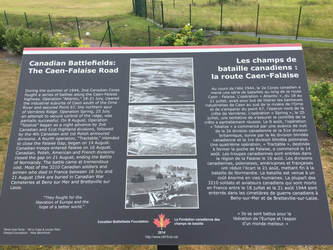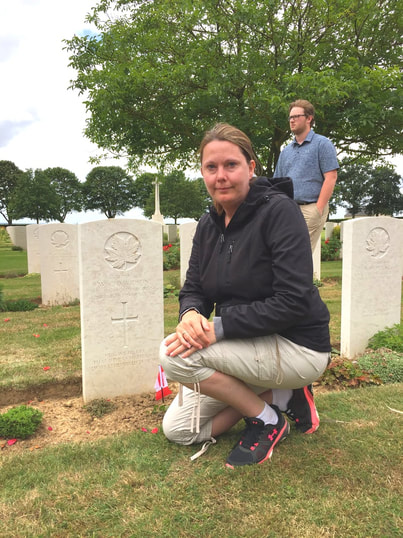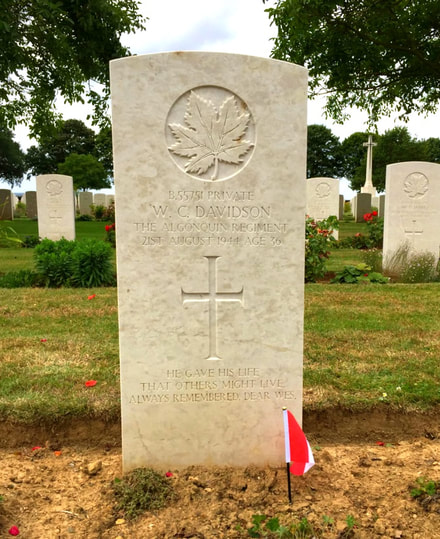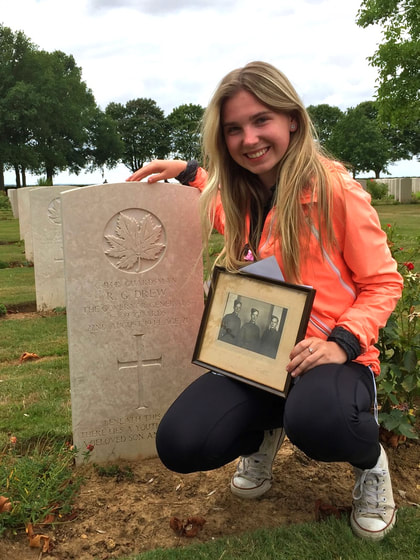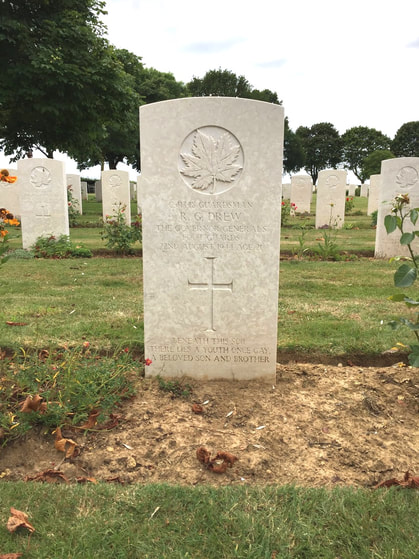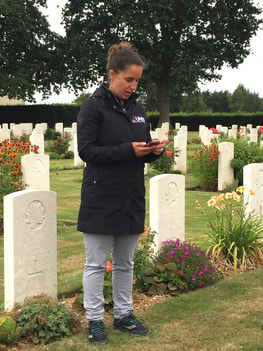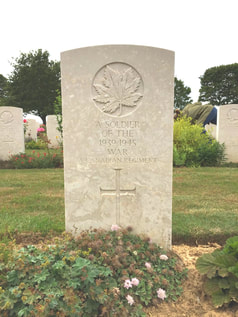"What context do we miss when we only teach students about D-Day?"
Today's Itinerary and Activities
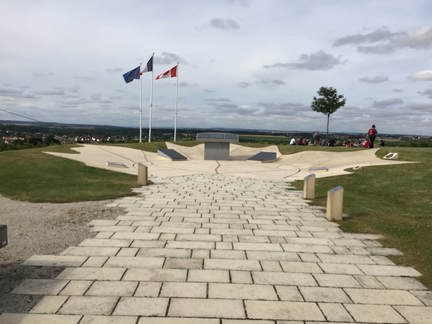 The memorial at Point 67 - Verrières Ridge
The memorial at Point 67 - Verrières Ridge
Today we visited sites south of Caen pertinent to an unknown part of the Normandy Campaign: the Battle of Verrières Ridge.
Our day began at Point 67 - Verrières Ridge, where there is a memorial that commemorates the Canadian units that struggled for Verrières Ridge in July and early August 1944. Before interrogating the site, Cindy guided us through an inquiry-based learning activity involving photographs. Following our investigation of the Point 67 memorial and look-off, Lee explained the historical significance of the Battle of Verrières Ridge.
Our second stop of the day was the village of Verrières. Specifically, we visited a church in front of which stands a memorial that commemorates the Royal Hamilton Light Infantry. While at Verrières, we discussed a few key aspects of history education. We then drove to Point 122, another significant site in the Normandy Campaign. While at Point 122, Blake assigned us our final group project, which involves syndicates designing a monument.
From Point 122, we drove to the Bretteville-sur-Laize Canadian War Cemetery where Lori, Emily, and Cindy presented their soldier biographies. After the presentations, Simon led a seminar during which we discussed the ethics surrounding the murders of innocent people during wartime.
When we returned to the Moulin Morin, we shared a communal dinner that has come to be known as the Chow Dinner.
Our day began at Point 67 - Verrières Ridge, where there is a memorial that commemorates the Canadian units that struggled for Verrières Ridge in July and early August 1944. Before interrogating the site, Cindy guided us through an inquiry-based learning activity involving photographs. Following our investigation of the Point 67 memorial and look-off, Lee explained the historical significance of the Battle of Verrières Ridge.
Our second stop of the day was the village of Verrières. Specifically, we visited a church in front of which stands a memorial that commemorates the Royal Hamilton Light Infantry. While at Verrières, we discussed a few key aspects of history education. We then drove to Point 122, another significant site in the Normandy Campaign. While at Point 122, Blake assigned us our final group project, which involves syndicates designing a monument.
From Point 122, we drove to the Bretteville-sur-Laize Canadian War Cemetery where Lori, Emily, and Cindy presented their soldier biographies. After the presentations, Simon led a seminar during which we discussed the ethics surrounding the murders of innocent people during wartime.
When we returned to the Moulin Morin, we shared a communal dinner that has come to be known as the Chow Dinner.
Inquiry-Based Activity: Photograph Analysis
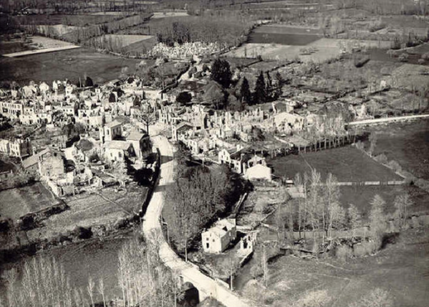 This photograph depicts Oradour-sur-Glane after the SS torched the town and assassinated hundreds of its civilians in summer 1944
This photograph depicts Oradour-sur-Glane after the SS torched the town and assassinated hundreds of its civilians in summer 1944
While we were at Point 67 - Verrières Ridge, Cindy led an inquiry-based learning activity, demonstrating how we can use photographs as jump-off points for controversial debates.
Cindy showed us two photographs taken during the latter days of the Battle of Normandy. She then posed a few Powerful Questions to guide our analysis of the images:
After giving us a few minutes to study the photographs, Cindy explained that one photograph is an aerial shot of Caen following the July 1944 bombings of the city. She then interpreted the second image, explaining that it depicts Oradour-sur-Glane, a town in west-central France that was never rebuilt following the 10 June 1944 massacre of its civilians by a unit of the 2nd SS Panzer Division Das Reich. She also informed us that the photograph of Oradour-sur-Glane was taken by the Germans.
Cindy concluded the activity by explaining that it is essential for teachers and students to question and research where the images they use as evidence come from.
Cindy showed us two photographs taken during the latter days of the Battle of Normandy. She then posed a few Powerful Questions to guide our analysis of the images:
- Who might have taken the photographs?
- Do the images depict the bombing of the same town?
- What was the purpose of the photographers?
- How much collateral damage is acceptable during wars?
- Who is responsible for the civilian population during and after wars?
After giving us a few minutes to study the photographs, Cindy explained that one photograph is an aerial shot of Caen following the July 1944 bombings of the city. She then interpreted the second image, explaining that it depicts Oradour-sur-Glane, a town in west-central France that was never rebuilt following the 10 June 1944 massacre of its civilians by a unit of the 2nd SS Panzer Division Das Reich. She also informed us that the photograph of Oradour-sur-Glane was taken by the Germans.
Cindy concluded the activity by explaining that it is essential for teachers and students to question and research where the images they use as evidence come from.
Key Points To Consider About Verrières Ridge
|
After our investigation of Point 67, we came together and Lee briefly shared some of the research he has conducted about the Battle of Verrières Ridge:
|
Reflections on Verrières Ridge
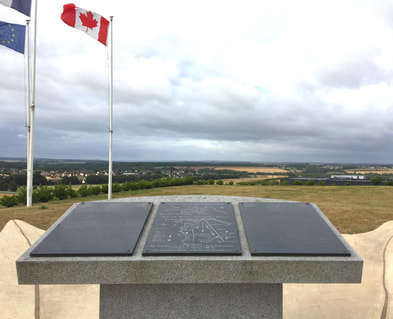 The Point 67 memorial site overlooks Caen
The Point 67 memorial site overlooks Caen
After we departed from Point 67 - Verrières Ridge, Joel shared the following reflection:
- Joel: "I do not know enough about this phase of the Normandy Campaign and this is likely the case for most civilians. The significance of these adverts for Canada and for Canada's contribution to the liberation of Europe is a story that needs to be told are better. The narrative of defeat and failure needs to have a counter. And that is likely common for most civilians. The significance of these adverts for Canada and for Canada's contribution to the liberation of Europe is a story that needs to be told better. The narrative of defeat and failure needs to have a counter. The ground at Verrières Ridge is particularly interesting as a means to study combined arms fire and movements on both the advance and the defence. The significance of the advancement and the enormity of the losses (Canadian/Allied and German) combined with the lack of knowledge about the series of battles (when compared with the Vimy, Dieppe, and Juno narratives) is striking and demands a further assessment and information campaign."
History Education: Best Practices
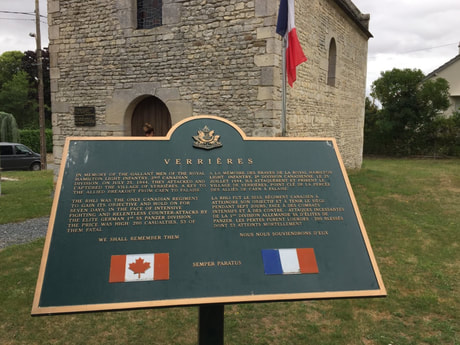 This plaque commemorates the Royal Hamilton Light Infantry, the regiment that captured Verrières from the Germans in July 1944
This plaque commemorates the Royal Hamilton Light Infantry, the regiment that captured Verrières from the Germans in July 1944
During our stop in the town of Verrières, Blake shared some important points about history education:
- Research has shown that students learn the most when teachers contextualize and problematize their learning.
- Research studies have demonstrated that unit-based teaching promotes procrastination.
- The most important pages of History curricula are the first twenty or so "front matter" pages because they outline the Big Ideas and historical thinking skills that students need to learn. Content is the vehicle through which students learn the Big Ideas and skills outlined in the "front matter."
- If teachers work with Big Ideas, they can design their curricula in any way.
- To practice democracy, teachers must allow students to share their opinions and wrestle with controversies around the world wars.
- Teachers must be aware that textbooks are political and promote certain narratives. To ensure that students understand different perspectives on historical events, teachers must ensure that their students study evidence from different sources.
- Battles are easy deliverables; however, they have very little context in the complexities of war. Consequently, it is important for teachers to recognize and counteract how much learning is lost when their students only study battles.
- It is important for students to research the macro instead of the micro because studying the whole story allows students to understand context, causes, and consequences.
- Not all presentism values were applicable seventy years ago. Furthermore, presentism values are not always in alignment with perspectives of the past. As such, when studying evidence, teachers and students must consider whose voices are heard and whose voices are missing.
Should teachers express their biases?
Today we discussed briefly whether teachers should share their biases or whether they ought to remain neutral. Lynzee, a teacher, and Marshall, a student, shared their thoughts on this matter:
- Lynzee: "I personally think it is not necessary for us to express our biases to our students. It would be useful for them to come up with their own opinions and perspectives. However, perhaps to build trust and connections, why would they express their perspectives if we don't share ours. Hopefully we could build a dynamic where multiple perspectives are projected and portrayed. I think asking them to debate opposing opinions, their own and other group work of respecting opinions but not necessarily having to agree with them is a good foundation."
- Marshall: "Teachers shouldn't express biases to their students because it simply isn't what they're paid to do. They're paid to teach facts, and truth, that is their job. I don't mind if teachers inflict a little bit of their biases to help the way they teach something, but I think certain biases have no place when teaching kids. Students should be given a neutral standpoint so they can decide their own biases on their own. Especially in a civics classroom when discussing politics, or in a history room teaching our own countries historical facts and how they played out."
Point 122
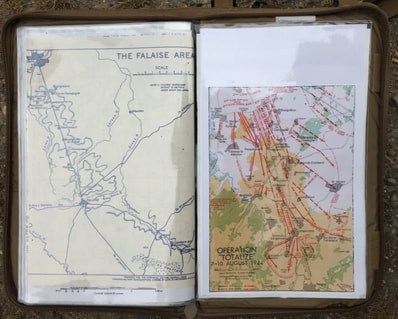
Point 122 is located along the 1944 Caen-Falaise Road. When we arrived at Point 122, Lee shared some evidence-based information about the historical significance of the site:
The divisions of the 2nd Canadian Corps came together for the first time during the Second World War to fight at Point 122. They were joined by the 51st Highland Division, whose troops also fought under Canadian command. The troops fighting at Point 122 employed sophisticated and innovative military tactics such as heavy bombers and multinational/multilingual operations.
Point 122 is where the vast majority of Canadians were killed during the Normandy Campaign. As well, the majority of the Germans who were captured during the Battle of Normandy were captured somewhere between Caen and Point 122.
Thanks to the Canadians' significant contributions during the fighting at Point 122, Canada became an independent party in the United Nations (UN) and in the North American Treaty Organization (NATO).
The divisions of the 2nd Canadian Corps came together for the first time during the Second World War to fight at Point 122. They were joined by the 51st Highland Division, whose troops also fought under Canadian command. The troops fighting at Point 122 employed sophisticated and innovative military tactics such as heavy bombers and multinational/multilingual operations.
Point 122 is where the vast majority of Canadians were killed during the Normandy Campaign. As well, the majority of the Germans who were captured during the Battle of Normandy were captured somewhere between Caen and Point 122.
Thanks to the Canadians' significant contributions during the fighting at Point 122, Canada became an independent party in the United Nations (UN) and in the North American Treaty Organization (NATO).
Inquiry-Based Project: Monument Design
While we were at Point 122, Blake pointed out that there is no national monument to commemorate Canada's experiences in the Second World War. He subsequently challenged syndicates to design a national monument. He reminded us that we must consider several components:
- The monument's location;
- Structures, symbols, text, and materials to include in the design;
- Design and construction costs (and who will cover them); and
- The unveiling of the site (e.g. who to invite).
First World War Versus Second World War CWGC Cemeteries
Over the past twelve days, we have visited many Commonwealth cemeteries. Following our visit to the Bretteville-sur-Laize Canadian War Cemetery, Abbi and Marshall compared and contrasted First World War and Second World War CWGC cemeteries.
- Abbi: "As we travelled from examining First World War to Second World War CWGC cemeteries it became evident to me that there were a few differences. Many First World War cemeteries we visited were battle cemeteries, which represented the soldiers that died and were buried in that location. In some locations, head stones were facing in different directions if they discovered a body but did not disturb the site. Furthermore, some cemeteries are remnants of aide stations or hospitals where the soldiers were buried if they were sent to that station. In comparison, I noticed that many of the Second World War cemeteries were planned; as a result all of the headstones and grave plots were planned in accordance to the designers intention. Soldiers from various battles would be buried alongside one another as opposed to being buried where they died."
- Marshall: "I did not see any differences in First and Second World War Commonwealth cemeteries. I think they're both kept to remember and respect the dead. The gravestones have different inscriptions, but other than that I saw no differences."
Soldier Biographies
Lori's Soldier
Private Wesley Clayton Davidson
Algonquin Regiment, R.C.I.C.
Bretteville-sur-Laize Canadian War Cemetery
Private Wesley Clayton Davidson
Algonquin Regiment, R.C.I.C.
Bretteville-sur-Laize Canadian War Cemetery
Emily's Soldier
Guardsman Robert Gregory Drew
Governor General's Foot Guards, R.C.A.C.
21st Armoured Regiment
Bretteville-sur-Laize Canadian War Cemetery
Guardsman Robert Gregory Drew
Governor General's Foot Guards, R.C.A.C.
21st Armoured Regiment
Bretteville-sur-Laize Canadian War Cemetery
Cindy's Soldier
A Soldier of the 1939-1945 War
A Canadian Regiment
Bretteville-sur-Laize Canadian War Cemetery
A Soldier of the 1939-1945 War
A Canadian Regiment
Bretteville-sur-Laize Canadian War Cemetery
Seminar
Before leaving the Bretteville-sur-Laize Canadian War Cemetery, we gathered together for Simon's seminar. After posing the question Can war justify the murder of innocent people such as civilians?, Simon engaged us in a large group discussion.
Gallery
Where we are |
Contact Us |
